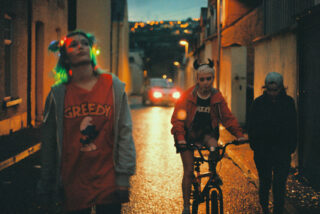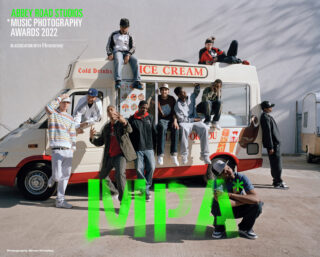Abbey Road Music Photography Award winner Megan Doherty on capturing outsiderness
We speak to the winner of the Championing Scenes category, sponsored by Hennessy

We speak to the winner of the Championing Scenes category, sponsored by Hennessy
Promotional partnership
When you think of the classic images that depict genres of music or cultural scenes, they’re almost always in the places where the music is happening. Think of Steve Strange patrolling the Blitz Club, or flick through the photographs Roy De Cavara’s The Sound I Saw, chronicling the New York jazz scene of the ’50s and ’60s, and these era-defining shots are almost audible. But musicians aren’t always in the club, the studio or the practice room, and what happens outside of those spaces informs their creativity just as much as what goes on inside them. Derry-based photographer Megan Doherty intrinsically understands this, and her photographs of musicians from her hometown evokes this flipside of their lives, away from the music, but retaining the emotion.
It’s for those photographs in general, and one in particular, ‘On Top of the Hill, 2016’, (displayed above) that Doherty won one of the inaugural Abbey Road Music Photography Awards earlier this month, in the Championing Scenes category. We caught up with her to talk about her process and inspiration, and to find out how the other side of her subjects’ lives, away from the live show or the act of music creation, still feeds the community that they’re a part of.

That particular image came from a series I was creating here in Derry that was born out of the idea of escapism. The three people started off playing specific characters, but it slowly became more of a documentation of us just hanging out. The image was taken outside my friend’s house – we were coming up the road and I happened to turn around, see this car coming up behind with the city lights, and the whole scene just blew my mind, so I snapped it in that moment.
It was one of those ones where it was completely in the moment: if that car hadn’t been there that second, it would’ve just come out completely underexposed, but with the headlights, everything just came together.
Of the three people in that photo, two are musicians, and the other one doesn’t establish themselves as a musician but they do play. But it wasn’t so much about showing them off as musicians; it was more about showing how they live their day-to-day lives and Derry and the other things that go on alongside the music scene.
I’m very inspired by cinema, so a lot of that bleeds into my work and when I set out to make an image. I love Wong Kar-wai, particularly In The Mood For Love, that saturation and color. And Sophia Coppola too. My starting point is always more towards creating something that has aesthetic beauty rather than telling a story or whatever, but sometimes you just can’t touch a scene if you feel like it’s playing out as it is and it should be captured as it is.
I think there’s a mood shift in people when it comes to that time of night, where they behave differently than they do in the day, and I love that kind of psychological atmosphere: it’s darker, it’s more atmospheric, and I feel like the real kind of fun in people comes out more in the nighttime.
But it’s also an aesthetic choice: I’m always drawn to grainier and darker images. It’s always a technical challenge, too, because you’ll get a lot of underexposed images, but when you hit that sweet spot and you get the highlights and the shadows perfectly going, it’s just so satisfying.
I’m one of the outsiders, too – the people in the photographs and I came together from seeing each other at music events, and we were just drawn to one another, and as much as I am an observer and photographing these guys, I’m also very much present in the photograph through trying to communicate my vision of this world.
I suppose everyone acts up for the camera, so that changes the scene: when it comes out, everyone wants to give their best performance for it, dress up more, or just behave differently. But I love that line between reality and performance, what’s real and what’s not, and that’s something I’m always trying to harness.
Some people will call me a documentary photographer, but I think I’m kind of half and half: where documentary photographers might feel like what makes them strong is the ability to make themselves invisible and let the real scene play out, in terms of what I do, it’s more back and forth – if I look at something and think that’s a good photograph but it could be better, I’ll intervene just to try and shape it more to my vision.
But to get people to just ignore you when the camera’s out, and just continue what they were doing also requires a level of trust – you can’t just head into some scenes when you don’t really know anyone that well, into an absolutely intimate moment. That’s just not going to happen, without trust and permission.
In this case, we’ve been building this friendship group for years, so they’re just used to me being around, and that trust is built over time. But if you’re on set with someone or you’re doing a short-term commission and want to gain someone’s trust, you need to give over a part of yourself. You just can’t stand rigid with the camera and be this person in charge and expect them to give you a photograph. You have to give some of yourself to them, so they feel like they can give it back.
For more information, head to abbeyroadmusicphotographyawards.com